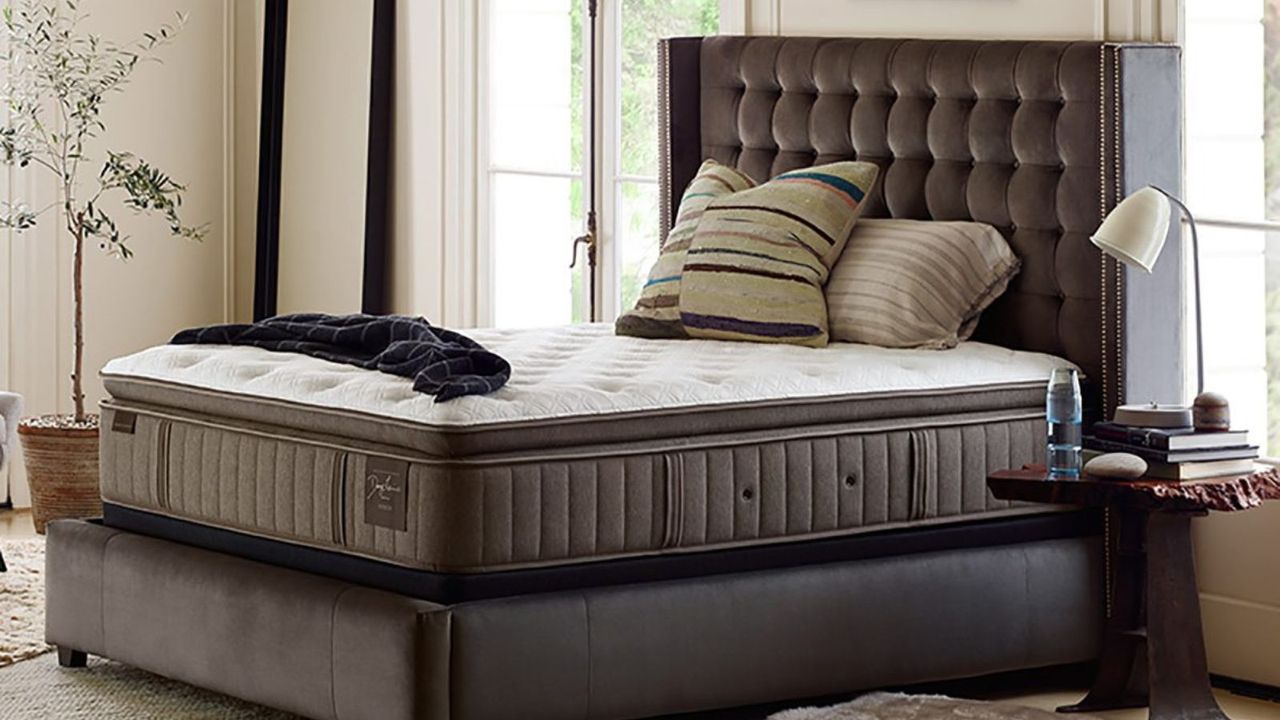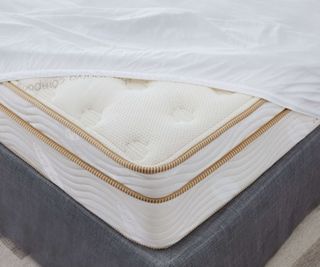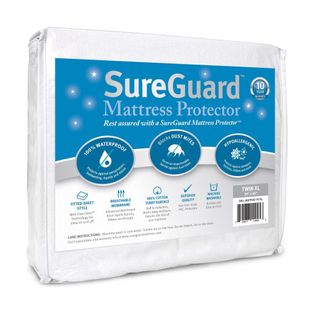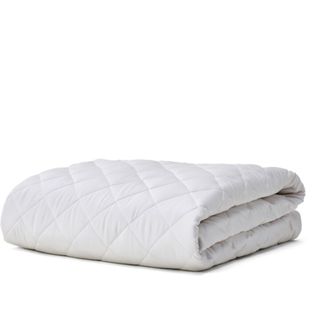How to store a mattress − 4 tips from decluttering experts
I asked a panel of home organization experts how to store a mattress to free up floor space and keep your sleeping surface clean


There are several reasons why you might need to know how to store a mattress. Perhaps you're moving house, renovating or redecorating, or you've just bought a new bed, and you're looking for a temporary space to store your old one. Whatever your circumstances, it's important to learn how to store a mattress in a safe, hygienic fashion.
Your average mattress is thick, heavy, and unwieldy, filled with dense foam or lined with steel springs. You can't just fold up a mattress and pop it in a closet – there simply isn't space. Plus, improper storage could cause irreparable damage to your mattress, making it much harder for you to fall asleep should you choose to use it again.
As H&G's cleaning and decluttering expert, I can teach you how to store a mattress like a home organizing expert. Here's how to free up some floor space and pave the way for better sleep once you bring your mattress out of storage.
How to store a mattress
The best place to store a mattress is in a large, dry area of your home. You want to find a space with good air circulation to prevent the growth of mold, must, and mildew inside the mattress. I'd rule out damp basements and humid attics, though a well-insulated garage could be a good spot. Now that you've made some space, it's time to learn how to store the mattress to prevent damage.
1. Attempt to lay the surface flat

I spoke to REM-Fit's Laurie Goldsmith to learn her top tips for mattress storage. Wherever possible, Laurie recommends that you lay your mattress flat, 'as if it were on a bed base. This should protect the inner workings of a sprung mattress and help to retain its shape.' It's worth learning how often you should flip a mattress to ensure it doesn't wear out from its own weight.
I recommend you store your mattress somewhere cool and dry, like a ventilated garage, to reduce the risk of damage. It helps to store your mattress somewhere out of sight, in a low-traffic area of the home, where you won't have to tiptoe around it. In a pinch, you could always store your mattress under your bed. I suggest you vacuum the space beforehand and wipe down the surrounding walls with a damp cloth.
2. Limit the risk of falling

If you don't have the space to lay your mattress flat, and you're not prepared to pay for a storage unit, then Laurie says you could try to lean it up against the wall − as long as you're careful about it.
'Depending on the mattress type, your mattress might start to buckle under its own weight,' warns Laurie. As a general rule, foam and latex beds fare better on their sides than anything with springs. 'Make sure to check your mattress regularly and rotate it regularly to prevent sagging around the pressure points.'
'If you have the space and a spare item of furniture available, you could sandwich the mattress against the wall to keep it upright,' adds Laurie. That way, you should prevent any alarming thuds in the night when your mattress falls over and safeguard surrounding furniture.
3. Invest in a protective cover

If you're putting a mattress into storage rather than reselling or recycling it, then the chances are that you'd like to use that mattress again. In order to keep your mattress in working condition, you should invest in the best mattress protector, which will guard against dust, dirt, and dander and inhibit the growth of mold and mildew.
According to our resident sleep writer, Emilia Hitching, your best bet for 360-protection is a mattress encasement. 'A mattress encasement should cover the top and bottom of your mattress, as well as all four sides, and zip up safely to keep bed bugs and bacteria at bay,' explains Emilia. These are three of her favorite mattress protectors for hygienic sleep.

This mattress encasement is made from 100% cotton terry cloth for natural waterproofing. It's perfect protection against perspiration, spills, stains, mold, and mildew. The SureGuard Mattress Protector is machine-washable and dryer-safe for quick and convenient cleaning.

This is one of the best-selling mattress protectors on Amazon, with more than 200,000 verified five-star reviews. One customer claims that their wife gave birth on their mattress, and once they removed the SafeRest Premium Mattress Protector, the mattress was bone dry.
4. Check the mattress regularly

If you're planning on storing your mattress for months at a time, then it's even more important to check it over for signs of damage. I asked Gabriella Dyson, our Solved section editor, for her mattress storage warning signs.
'When checking on a mattress that has been stored for longer than one week, it's important to check for signs of damage such as moisture on the inside of the bag, lumps or misshapen edges, mold spots, and rips and tears,' says Gabriella.
Spotting any of these early enough should allow you to rectify the issues before it is too late. It might be that the mattress needs to be flipped or moved entirely to a new spot if the humidity or temperature isn't right.
FAQs
How long can you store a mattress vertically?
With the right support, you could get away with storing a mattress vertically for up to a year. You want to find a tight frame or vacuum storage bag to squeeze together the front and back of the mattress, or else the foam and springs might start to deform.
Generally, it's best to store a mattress flat, without anything on top of it.
Is it okay to leave a mattress rolled up?
I'm guessing you're talking about a box mattress, which arrives vacuum-packed and compressed in a cardboard box. As a mattress tester, I would feel comfortable leaving my mattress in its box for a few days while I set up my sleeping quarters.
I would make sure to unroll the mattress and lay it out flat within three weeks of arrival to prevent permanent misshaping. Remember, too, that you'll need to set aside 24-48 hours for the box mattress to inflate to its full size.
Final thoughts
Once you bring your mattress out of storage, I recommend you give it a good clean to remove any dust or debris that might have made their way into the mattress. It's worth learning how to clean a mattress from our expert guide for safe, hygienic sleep.
Sign up to the Homes & Gardens newsletter
Design expertise in your inbox – from inspiring decorating ideas and beautiful celebrity homes to practical gardening advice and shopping round-ups.

Chiana has been at Homes & Gardens for two years and is our resident 'queen' of non-toxic living. She spends most of her time producing content for the Solved section of the website, helping readers get the most out of their homes through clever decluttering, cleaning, and tidying tips. She was named one of Fixr's top home improvement journalists in 2024.
-
 Are weeds really the enemy? Why so-called problem plants deserve a rebrand and maybe even a place in your yard
Are weeds really the enemy? Why so-called problem plants deserve a rebrand and maybe even a place in your yardFrom wildflowers to soil fixers, is it time we looked at weeds in a new light?
By Thomas Rutter Published
-
 Kris Jenner's unorthodox coffee table accessory promotes quality time with family – and it embodies effortlessly cool design
Kris Jenner's unorthodox coffee table accessory promotes quality time with family – and it embodies effortlessly cool designThe Kardashian Empire manager recommends using this non-traditional piece to liven your coffee table – it's exceedingly easy to recreate in any space
By Sophie Edwards Published
-
 6 ways to prevent mold and damp in bedrooms – expert solutions to maintain a safe sleep environment
6 ways to prevent mold and damp in bedrooms – expert solutions to maintain a safe sleep environmentDon't sleep on these six tips, experts urge
By Seraphina Di Mizzurati Published
-
 I tried the easy Reverse Advent Calendar decluttering method to clear out my home before Christmas – it's brilliant if overwhelm usually gets in your way
I tried the easy Reverse Advent Calendar decluttering method to clear out my home before Christmas – it's brilliant if overwhelm usually gets in your wayIt left my home feeling lighter with minimal effort
By Ciéra Cree Published
-
 I tried the one-in-one-out method to keep my space clutter-free and it changed my relationship with shopping for good
I tried the one-in-one-out method to keep my space clutter-free and it changed my relationship with shopping for goodI added a few caveats that made the rule work better for me
By Ciéra Cree Published
-
 8 things you should never store in a playroom and where to put them instead
8 things you should never store in a playroom and where to put them insteadRead our top tips on how to keep your playroom organized and fun at the same time
By Sophie Warren-Smith Published
-
 7 fall home maintenance tips experts never skip in their own properties
7 fall home maintenance tips experts never skip in their own propertiesSeven pro steps to maintain your home this fall
By Andy van Terheyden Published
-
 I’m in chronic pain and have used heating pads for 15 years to cope at home in cold weather – the best I've ever used is on sale for Amazon Prime's last day of deals
I’m in chronic pain and have used heating pads for 15 years to cope at home in cold weather – the best I've ever used is on sale for Amazon Prime's last day of dealsI've used more than 30 electric heating pads and they're my go-to for pain relief
By Punteha van Terheyden Published
-
 A professional organizer's best seasonal storage tips for living rooms – they're the key to having easy access, reduced clutter and improved functionality
A professional organizer's best seasonal storage tips for living rooms – they're the key to having easy access, reduced clutter and improved functionalityWelcome in the new season with stylish storage tips for fall
By Ottilie Blackhall Published
-
 How to elevate your teen's former bedroom into a beautiful home office
How to elevate your teen's former bedroom into a beautiful home officeTips and advice from an interior designer and a professional organizer on how to transition your teen's bedroom into a home office
By Ashley Chalmers Published
